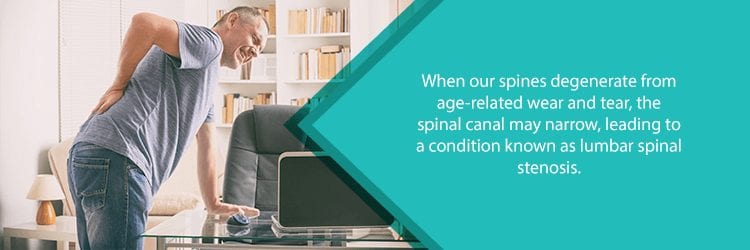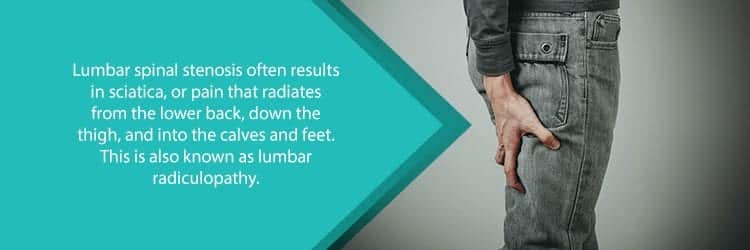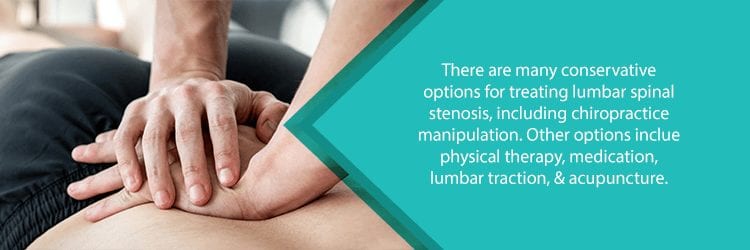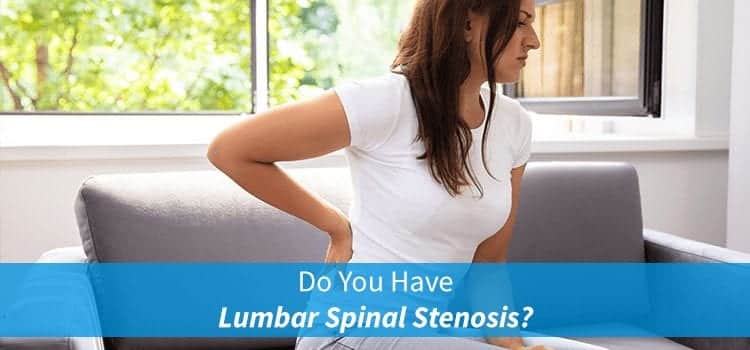Lumbar spinal stenosis (LSS) is a common cause of pain in the lower back and legs. As we get older, our spines go through changes. This is known as spinal degeneration, and it happens to everyone. That being said, even though it happens to everyone, not everyone has negative symptoms that accompany it. When our spines degenerate, the spinal canal may narrow, leading to a condition known as spinal stenosis.
Age-related spinal wear and tear occurs in 95% of people by the age of 50. However, spinal stenosis usually occurs in adults age 60 and older. When the spaces surrounding the spinal canal narrow, it may put pressure on nearby nerves, causing pain. Pressure such as this affects both genders equally.
A minority of patients are born with congenital back problems that later develop into lumbar spinal stenosis. Appropriately, doctors refer to this form of the condition as congenital spinal stenosis. Usually, this form of the condition occurs in men, but it may occur in women as well. For congenital spinal stenosis, symptoms typically manifest between the ages of 30 and 50.

Lumbar Spinal Stenosis Causes
Out of all possible causes, degenerative arthritis is the most common culprit of spinal stenosis in patients. For context, arthritis refers to the degeneration of any joint at any point in the body.
In our spines, arthritis results from disc degeneration and the loss of water content. In younger patients, spinal discs have a higher level of water content. However, as patients grow older, the discs begin to dry out, and in turn, they weaken. This may lead to a slew of other problems, such as lumbar radiculopathy or degenerative scoliosis.
As the spine settles, the weight transfers to the facet joints. Additionally, the tunnel that the nerves exit through becomes smaller. As the joints experience increased pressure, the cartilage that protects these joints wears away. If it wears away completely, it results in bone rubbing on bone and causing pain.
When the body loses cartilage in this manner, it may also try to make up for the lost bone by growing new bone in the facet joints. This may sound like a good thing, but it actually leads to the formation of bone spurs. These bony protrusions may put additional pressure on nearby nerves, leading to unpleasant symptoms.
In some cases, the body may respond to arthritis in the lumbar spine by increasing the ligaments around the joints in size. This is known as facet joint hypertrophy, and it also lessens the space surrounding the nerves in the spine. Once the surrounding spaces become small enough, it may irritate the spinal structures.
Lumbar Spinal Stenosis Symptoms
LSS symptoms will vary on a case by case basis. Some patients may experience no symptoms at all, but others may find that they have the following ailments:
- Burning pain in the buttocks/legs: One word, sciatica. Pressure on the spinal nerves may result in pain to innervating areas within the body. Patients describe this pain as either an aching or burning feeling. It usually starts in the buttocks region and radiates all the way down the leg and sometimes into the foot. The latter, however, only occurs when the condition progresses without treatment.
- Back pain: Again, back pain may or may not occur in patients with LSS. It all depends on the severity of arthritis in the patient.
- Foot drop: When the pressure reaches a critical point, weakness may occur in one or both legs. Doctors sometimes refer to this as foot drop, as patients feel that their foot slaps the ground when they walk.
- Numbness or tingling: As nerve pressure increases, numbness and tingling often coincide with the burning pain. Of course, not all patients will have this symptom along with pain, but it does exist in some cases.
- The pain lessens with leaning forward/sitting: Studies show that leaning forward may actually increase the space available for the nerves. Because of this, many patients feel relief when leaning forward, especially when sitting. However, this pain usually worsens when standing up straight or walking. Some patients find that they are able to ride a stationary bike or walk while leaning on a rolling object (such as a walker). Walking more than a few hundred feet, however, may bring on weakness or severe sciatica.

Lumbar Spinal Stenosis Diagnosis
First, you will discuss your medical history and symptoms with your doctor while they examine your back. This examination includes looking at the back and pushing on different areas to find the affected spots. Your doctor also may have you bend forward, side-to-side, and backward to look for movement limitations or pain in general.
Other tests that your doctor may order to confirm a diagnosis include:
- MRIs: Sort of like a more advanced x-ray, this test creates better images of soft tissues such as muscles, discs, nerves, and more.
- X-rays: X-rays only really visualize bones, but this is helpful when it comes to making a diagnosis for LSS. This test will show aging changes responsible for LSS, such as loss of disc height or bone spurs. Your doctor may administer the x-ray while you lean forward or backward to help better showcase the instability in the joints. Sometimes, x-rays may reveal too much mobility. This is known as degenerative spondylolisthesis.
- CT Scans: Like MRIs, these provide a more detailed cross-section of the spine and its structures.
- Myelogram: Your doctor will inject dye into the spine to make sure that your nerves show up more clearly. This will help determine whether or not the nerves in that area are being compressed.
Lumbar Spinal Stenosis Treatment
For most medical conditions, treatment comes in two forms: surgical and nonsurgical. Most doctors will exhaust all conservative options before considering surgery unless the patient’s condition is too severe for this to be a consideration. Some examples of nonsurgical treatments include:
- Physical Therapy: Involves special exercises, stretching, and massages to help manage symptoms.
- Medication: NSAIDs help reduce pressure by decreasing inflammation around the nerves. This, in turn, relieves pain.
- Lumbar Traction: This is only helpful in some cases. Scientific evidence supporting this treatment is limited.
- Steroid Injections: Cortisone injections in the nerves or epidural space will help decrease swelling as well as pain. This, however, is only a temporary treatment and multiple injections are required for it to be effective over time.
- Chiropractic Manipulation: Make sure to find a fully licensed chiropractor if you wish to take this avenue. Spinal manipulation may improve symptoms, but in some patients, it might make things worse.
- Acupuncture: Not the most common treatment, nor scientifically proven, but anything for pain relief is worth a shot. Some patients find this treatment to be very effective. It is at least worth trying because it is inherently safe.
These are just a few examples of nonsurgical treatments that doctors use to treat LSS. In the event that conservative methods do not work, your doctor may recommend surgery. Usually, for LSS, doctors will either perform a laminectomy or spinal fusion. What procedure your doctor decides to use will depend on a variety of factors. Communicate with your doctor and stay informed as much as possible.

Contact Us
Do you have any of the symptoms above? If so, you may want to contact us at (855) 586-2615. Our doctors at NJ Spine and Orthopedics are dedicated to conservative and minimally invasive treatments that are right for you. Our team will work tirelessly to ensure that you are put on a care plan that suits your specific needs.

